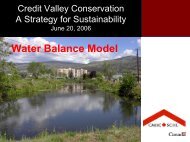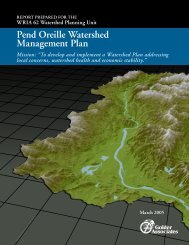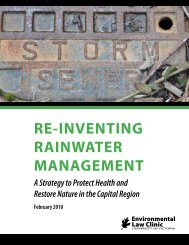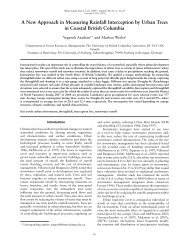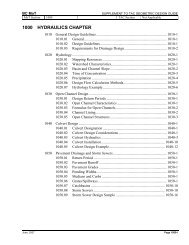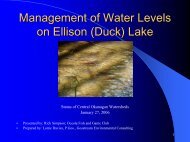Stormwater Source Control Design Guidelines 2005 - Waterbucket
Stormwater Source Control Design Guidelines 2005 - Waterbucket
Stormwater Source Control Design Guidelines 2005 - Waterbucket
Create successful ePaper yourself
Turn your PDF publications into a flip-book with our unique Google optimized e-Paper software.
Green Roof <strong>Stormwater</strong> <strong>Source</strong> <strong>Control</strong> <strong>Design</strong> <strong>Guidelines</strong> <strong>2005</strong>hose bib for manual watering during establishment if noautomatic irrigation system is planned.3. Roofs with less that 2% slope require special drainageconstruction so that no part of the growing medium iscontinuously saturated. As the slope increases, so doesthe rate of rainfall leaving the roof. This can becompensated for by using a medium with high waterstorage capacity. Roofs with over 20º require specialprecautions against sliding and shearing (FLL. 2002). Ifinverted roof systems are used with exterior insulation,good drainage needs to be provided to prevent continuoussaturation of the insulation, and subsequent damage (Peck& Kuhn, 2001). With inverted roofs, the green roofcomponents must allow moisture to move upwards fromthe insulation and to eventually evaporate (Krupka, 1992).Photo Credit: Lanarc Consultants Ltd.4. Provide plant free zones to facilitate access for inspectionsand maintenance and prevent plants from spreadingmoisture onto exposed structural components. They canalso function as a measure against fire and wind-uplift.They should be at least 50 cm wide and located along theperimeter, all adjacent facades and covered expansionjoints, and around each roof penetration.5. Fire breaks of non-combustible material, such as gravel orconcrete pavers, 50 cm wide, should be located every 40m in all directions, and at all roof perimeter and roofpenetrations (FLL, 2002). Other fire control optionsinclude use of sedums or other succulent plants that havea high water content, or a sprinkler irrigation systemconnected to the fire alarm (Peck & Kuhn, 2001).Newly planted extensive green roofshowing plant-free zones at drain andedges – White Rock Operations Building6. There are several choices of waterproof membranes.Thermoplastic membranes, such as PVC (polyvinyl choride)or TPO (thermal polyolefin) using hot air fusion methodsare commonly used for green roof applications.Elastomeric membranes like EPDM (ethylene-propylenerubber materials) have high tensile strength and are wellsuitedto large roof surfaces with fewer roof penetrations.Modified bitumen sheets are usually applied in two layersand are commonly available. Liquid-applied membranesare generally applied in two liquid layers withreinforcement in between. The quality is variable. A factorin choosing a waterproofing system is resistance to rootpenetration (see point 7 below).7. Provide protection against root penetration of thewaterproof membrane by either adding a root barrier orusing a membrane that is itself resistant to root penetration66Greater Vancouver Sewerage & Drainage District



